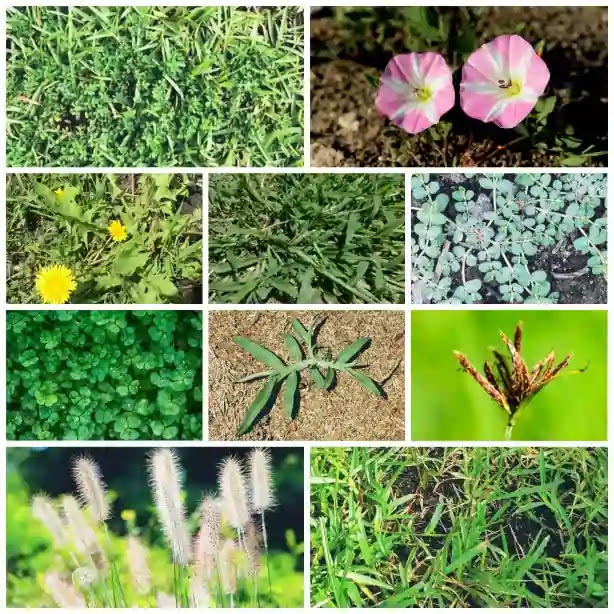Common weeds like warm climate conditions grow on roadsides, meadows, lawns, and gardens. North Carolina is a warm climate region that is habitable for various weeds. This causes several species and varieties of weeds in lawns.
Here, I'm going to give you info on such common weeds that grow in lawns in North Carolina.
Lawn weeds in North Carolina(USA)
Lawn weeds can be very different from each other. Some are plant weeds that bloom flowers, and some are grass weeds that look like lawn grass but their nature and growth are different than lawn grass. Also, Ash composting is not helpful to remove lawn weeds, instead it encourages them to grow but sometimes it can help to neutralize the acidic soil.
Let's understand every common weed one by one in North Carolina. First, their identification and then their common causes.
Crabgrass weed
Identification
- Size- 5 inches height(max) and grow horizontally
- Leaves- Multiple leaves in a single stem and multiple stems in a grass root.
- Color- Light green to normal green
- Flowers- No flowers
- Nature- Invasive and perennial
- Temperature- From 60F to 80F
- Season- Warm and summer
Common causes of growing
Land history, Birds, neighborhood, roadside meadows, etc.
Dandelion weed
Identification
- Size- 1-foot height, 2 inches diameter of flower
- Leaves- Long dragon tail leaves, 5 to 6 in a single weed
- Color- Yellow flowers, green leaves
- Flowers- Multiple on each plant weed
- Nature- Invasive
- Temperature- Over 55F
- Season- Warm climate, dry conditions
Common causes of growing
Land history, overmoisture, acidic soil, common spreading
Doveweed
Identification
- Size- 10 inches tall max.
- Leaves- Shiny and parallel
- Color- Dark green
- Flowers- Light pink
- Nature- Annual invasive
- Temperature- 60F and above
- Season- Warm climate
Common causes of growing
Seed mixed with grass seeds, no-drainage, acidic soil, through the air, roadside weeds, and common invasion.
Lespedeza weed
Identification
- Size- 3 to 5 feet tall
- Leaves- Green and flat at edges(not continuous)
- Color- Green leaves, whitish-Pinkish flowers
- Flowers- Marked at petals
- Nature- Invasive
- Temperature- 65F and above
- Season- Spring and summer
Common causes of growing
Land history, neighbor weeds, flower seeds, etc.
Nutsedge weed
Identification
- Size- 1 foot
- Leaves- Very thin, and long, with continuous lines
- Color- Green leaves, yellow flowers
- Flowers- Spiked yellow flowers at the top
- Nature- Invasive
- Temperature- From 60F to 85F
- Season- Spring and following
Common causes of growing
Seeds, no-drain, overmoisture, roadside spreading, meadows, etc.
Spurge weed
Identification
- Size- 6 inches tall, grows with rhizomes
- Leaves- Rounded small, present in a bunch
- Color- Dark green leaves, yellow flowers
- Flowers- Small yellow with a bunch
- Nature- Grow with rhizomes
- Temperature- Above 70F
- Season- Warm climate, 10% moisture
Common causes of growing
Nearby meadows, seeds, acidic soil, and neighborhood spreading
Goosegrass weed
Identification
- Size- 10 inches max
- Leaves- Like crabgrass, fleshy stem and folded leaves
- Color- Shiny green
- Flowers- No
- Nature- Invasive with seeds
- Temperature- From 62F to 88F
- Season- Early summer to mid fall
Common causes of growing
Animal contact, seed spreading, birds spreading, etc.
Foxtail weed
Identification
- Size- 1 to 3 feet
- Leaves- Like wheat leaves
- Color- Shiny green with a brown-whitish tail
- Flowers- No
- Nature- Invasive
- Temperature- 70F and above
- Season- Warm conditions with moderate moisture
Common causes of growing
Hybrid seeds, seed mixture, low-drainage, birds, nearby lawn weed spreading, etc.
Clover weed
Identification
- Size- 1 foot max(horizontal growth)
- Leaves- Triangular bunch of round-shaped leaves
- Color- Shiny green leaves and white flowers
- Flowers- Stress petals of flowers folded inside
- Nature- Invasive
- Temperature- From 55F to 85F
- Season- Spring to late fall
Common causes of growing
Rhizomes, seeds, land history, mixed hybrid seeds, Neighbour hood clover weeds, etc.
Bindweed
Identification
- Size- 16 inches max
- Leaves- Triangular heart-shaped with sharp cuts at the edges
- Color- Dark green leaves, white flowers
- Fowers- Too close wide white petals
- Nature- Invasive
- Temperature- 65F to 80F
- Season- Mid-summer to late fall
Common causes of growing
No drainage, mixed seeds, birds, meadows, etc.

